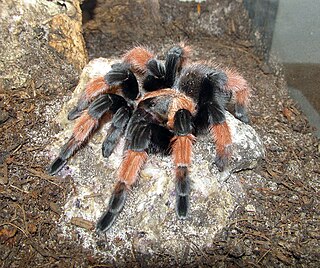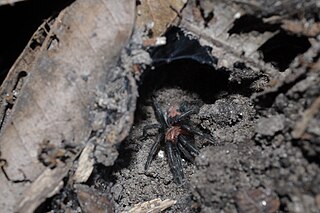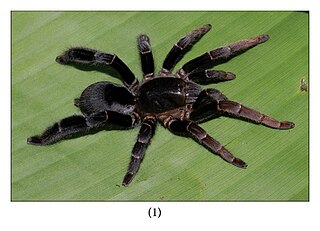
Brachypelma is a genus of spiders in the family Theraphosidae (tarantulas). They may have bodies up to 6 cm long with legs of similar or greater lengths. Some species have brightly colored legs, with red or orange marks and rings.

Brachypelma boehmei is a tarantula native to Mexico in Guerrero state. These long-lived tarantulas prefer burrowing and hiding in dry scrubland. As with all closely related tarantula species, they defend themselves with urticating hair when provoked.

Tarantulas comprise a group of large and often hairy spiders of the family Theraphosidae. As of December 2023, 1,100 species have been identified, with 166 genera. The term "tarantula" is usually used to describe members of the family Theraphosidae, although many other members of the same infraorder (Mygalomorphae) are commonly referred to as "tarantulas" or "false tarantulas". Some of the more common species have become popular in the exotic pet trade. Many New World species kept as pets have setae known as urticating hairs that can cause irritation to the skin, and in extreme cases, cause damage to the eyes.

The Mexican redleg or red-legged tarantula is a species of terrestrial tarantula closely related to the famous Mexican redknee tarantula. Like the redknee it is a docile tarantula and popular in the pet trade. It is slow growing and, like many tarantulas, females can live for decades.

The Texas brown tarantula, Aphonopelma hentzi, also known as the Oklahoma brown tarantula or Missouri tarantula, is one of the most common species of tarantula living in the Southern United States today. Texas brown tarantulas can grow to leg spans in excess of 10 cm (4 in), and weigh more than 85 g (3 oz) as adults. Their bodies are dark brown, though shades may vary between individual tarantulas. The colors are more distinct after a molt, as with many arthropods.

Brachypelma auratum is a tarantula endemic to the regions of Guerrero and Michoacán in Mexico. In appearance it is reminiscent of the quintessential Mexican red-kneed spider, Brachypelma smithi, albeit darker and with more discrete red striations on the patella. The form of these red markings have earned the spider its common name, the flame knee. Due to the species' similarities to B. smithi, it was not considered a distinct species until 1992. It has been found living communally with a small frog known as Eleutherodactylus occidentalis

Cyriocosmus is a genus of tarantulas that was first described by Eugène Louis Simon in 1903. They are small to medium spiders, with a bicolored or one same color carapace.

Davus pentaloris is a species of New World tarantula native to Mexico and Guatemala. Davus was at one time considered to be a synonym of Cyclosternum, and its species were placed in that genus, but this is no longer accepted.
Cyclosternum is a genus of tarantulas that was first described by Anton Ausserer in 1871.

The Theraphosinae are a large subfamily of Mygalomorphae spiders in the family Theraphosidae found in the Neotropical realm.

Ephebopus cyanognathus, known as the blue fang tarantula, is a species of tarantula. It is endemic to French Guiana. It was first described by Rick C. West and Samuel D Marshall in 2000, and is somewhat commonly kept as pets. As it common name may suggest, they have magnificent blue chelicerae, cyano meaning blue and gnathus meaning jaw. This tarantula is a burrowing spider, though spiderlings of this species have been observed to be semi-arboreal.
Ephebopus uatuman also known as the Emerald Skeleton Tarantula is a tarantula native to Brazil. It was first described by Lucas, Silva and Bertani in 1992. It is named after the Uatuman River.

Lasiodora is a genus of tarantulas that was first described by Ludwig Carl Christian Koch in 1850. They are often very large; body lengths of up to 25 centimetres (9.8 in), including the legs, are not unusual.

Phlogiellus is a genus of tarantulas that was first described by Reginald Innes Pocock in 1897. They are found throughout Asia and Papua New Guinea, including Indonesia, the Philippines, Papua New Guinea, China, Myanmar, Malaysia, Borneo, Thailand, the Solomon Islands and Taiwan. Phlogiellus is part Latin and part Greek, the first part being "φλóξ φλoγóϛ", meaning flame, the second part being "ellus" which is a latin diminutive suffix.

Davus, also known as the tiger rump tarantulas, is a genus of spiders in the family Theraphosidae (tarantulas). It was formerly included in Cyclosternum. They are medium to large tarantulas, found in Central America and Mexico.
Metriopelma is a monotypic genus of Mexican tarantulas currently containing the single species, Metriopelma breyeri. It was first described by Léon Becker (1826–1909) in 1878, and originally found by Eugenio Dugès (1834–1895). This tarantula was named after Albert Breyer (1812–1876), a fellow entomologist. It is native to Mexico in the state of Guanajuato.
Magnacarina is a genus of spiders in the family Theraphosidae. It was first described in 2016 by Mendoza, Locht, Kaderka, Medina & Pérez-Miles. As of 2017, it contains 4 species.
Rick C. West is a Canadian arachnologist and an expert on the taxonomy of tarantula spiders. West was born in Victoria, British Columbia. He has been interested in spiders since childhood, and collected his first tarantula, Aphonopelma eutylenum, at the age of 13. He worked primarily as a Chief Constable for a local Animal Humane Society, but also have been involved with the collecting, breeding, rearing and photography of theraphosid spiders. West has traveled to over 27 countries to document and study them in their environment, has been a host, presenter and co-producer in several tarantula documentaries and has also described several genera and species.
Hapalotremus chespiritoi is a tarantula in the Hapalotremus genus, first described by Nelson Ferretti, Patricio E. Cavallo, Juan C. Chaparro, Duniesky Ríos Tamayo, Tracie A. Seimon and Rick C. West in 2018. It is found in Peru, Patambuco, very close to Sicuani. This tarantula is named after Roberto Gómez Bolaños. The shape of the spermatheca of female of Hapalotremus chespiritoi resembles the small antennae of el "Chapulín Colorado", a comical superhero created by R.G. Bolaños.

Lyrognathus giannisposatoi sometimes called the Sumatran stout leg tarantula is a tarantula which can be found in Mesuji Regency, Sumatra, Indonesia. It was first described by Steven C. Nunn, Rick C. West in 2013, and is named after Gianni Sposato, who helped with Selenocosmia material, and was of great help to the authors.













